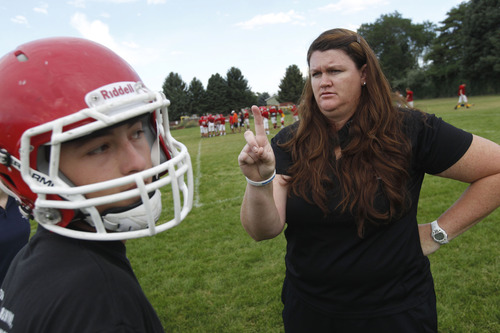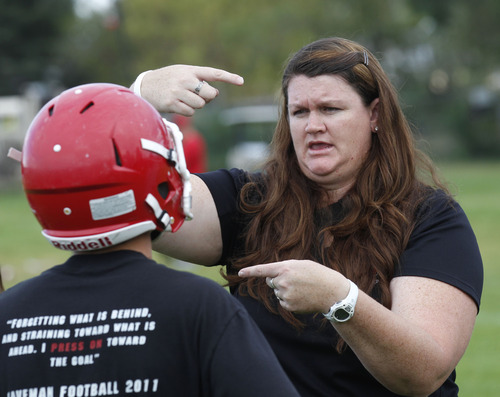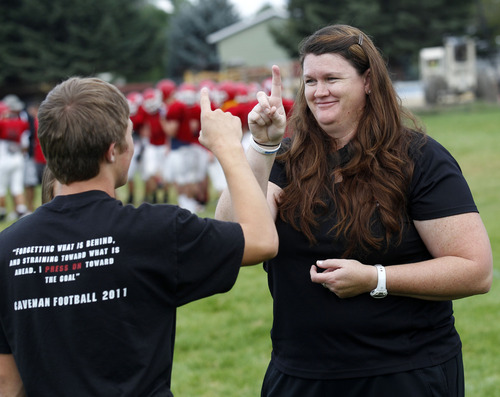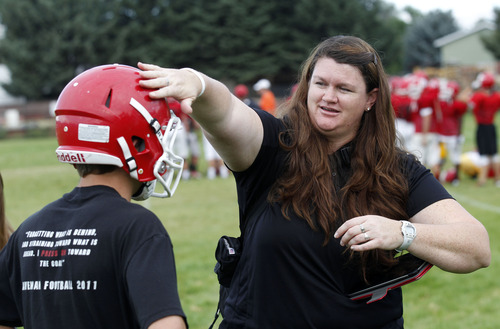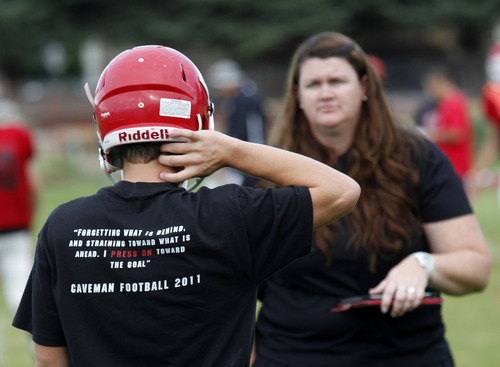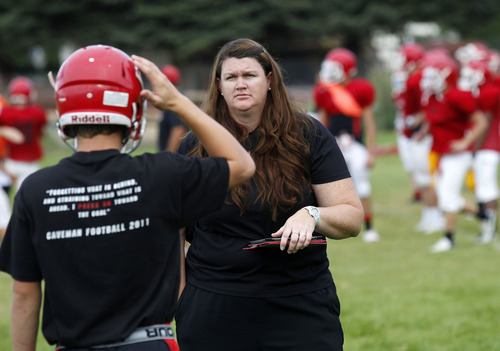This is an archived article that was published on sltrib.com in 2013, and information in the article may be outdated. It is provided only for personal research purposes and may not be reprinted.
American Fork • Haydn Bowden strapped on his helmet and jogged to a brown patch of dead grass, then back to his trainer.
He felt OK as he backpedaled to the same spot and back.
But after his trainer, Becky Bailey, made the junior quarterback do five "burpees," dropping to the ground, popping back up and jumping, the pain started to return. He felt it in the right side of his head as he listed off the words Bailey had given him earlier in the morning.
"Sugar, sandwich … sugar sandwich, paper, candle," he says. "There was another one. … Wagon!"
Two days earlier, Bowden was bent over picking up a loose ball in a drill when an offensive lineman hit him in the side of the helmet. His concussion symptoms were minor by comparison. But just two days into the Cavemen's padded practices, Bailey decided that Bowden needed to sit out for a day as his teammates worked toward the start of the football season.
Bowden has a lot of company. High school teams now routinely sit players who have suffered concussions, requiring them to pass cognitive tests before returning to the field. More changes may be on the way.
To reduce concussion risk, some states have imposed limits on full-contact practices once the football season begins.
In Alabama, high schools can conduct only 90 minutes of full-contact drills after the fourth week of the season. And in football-mad Texas, the same restriction exists after the first game has been played.
"We know the Friday night lights of Texas are important; it's one of the great things about this state," said Mark Cousins, the athletics director for the University Interscholastic League, the governing body of high school athletics in Texas. "But what we're doing is trying to make sure that health and safety is on the forefront of everything we do."
Bailey, a trainer at American Fork High School for the past 16 years, knows that concussions can happen in any sport — game or practice. She's already diagnosed three in the two days of padded practice.
Even so, Bailey said she would prefer to see data from states implementing practice limitations before changes are made in Utah. Officials at the Utah High School Activities Association agree.
"It came up at a national rules committee in January," UHSAA director of football Kevin Dustin said. "It is kind of a bubbling issue. Some states have decided to reach out and initiate the program. I'm waiting to see what the data shows from these states to see if it has some merit. If there is any merit to the idea that it would reduce concussions, then it's worthy of some discussion."
Other leagues and conferences at nearly every level of play already have taken that step. The Pac-12 announced this summer that it would limit the amount of contact in practices in an effort to cut down on concussions and other injuries. Such limitations already were in place in the Ivy League. The same goes for the National Football League.
Cousins said the restrictions have been largely non-controversial in Texas.
Some youth football leagues also have placed limitations on contact practice. But in a recent study of 18 youth teams in Pennsylvania, researchers at the University of Pittsburgh Medical Center found that concussions in practice were rare (just .24 incidences per 1,000 exposures).
Anthony Kontos, the assistant research director for the UPMC Sports Medicine Concussion Program, said his study shows limiting full contact in practice may not be the solution.
Instead, Kontos said, limiting contact could harm efforts to teach proper form and tackling technique, things that might have a greater impact in reducing the number of concussions.
"I kind of liken it to a simulator," he said. "If you're learning how to fly or drive and all you have ever done was use a simulator, and then you're told you're going to be out on the freeway or flying, I don't think we would ever advise that kind of approach."
In northern Utah, Logan Grizzlies coach Mike Favero said he would have safety concerns about cutting padded practice time.
"In society, we tend to be reactionary after the fact," he said. "You can limit contact, but if you limit it too much, you may increase the likelihood of poor play and injury during the game. … You can limit contact so a player never gets practice on how to tackle, but sooner or later he's going to have to make a tackle in a game."
Cousins said his coaches in Texas already had been limiting the amount of contact in practice to avoid injury before Friday.
Bailey, the American Fork trainer, said her school's football team is in a similar situation. The Cavemen practice in pads only on Tuesdays and Wednesdays once the season begins.
Even so, Bailey said she doubted putting limitations on practice "would ever fly in our state."
"Coaches want to have as much pad time as they can," she said.
Twitter: @aaronfalk —


